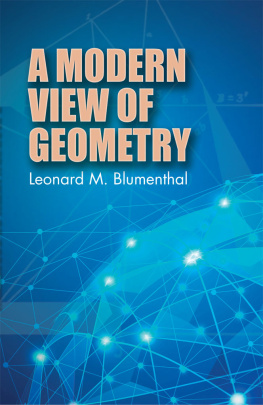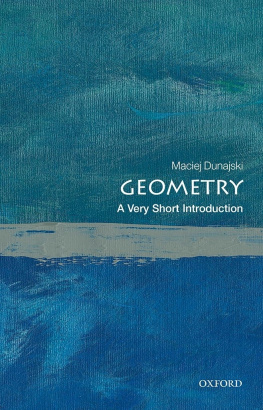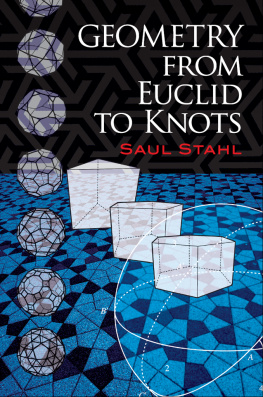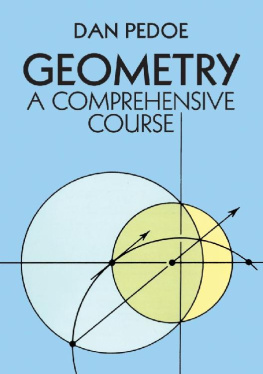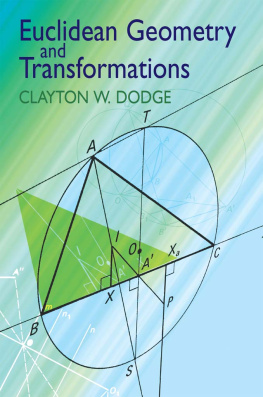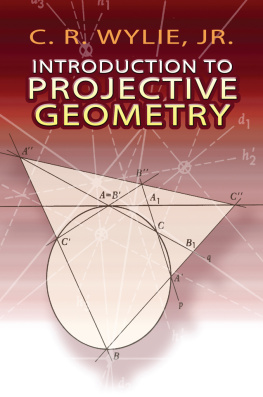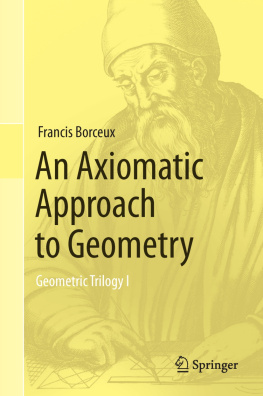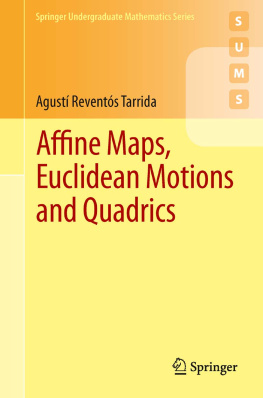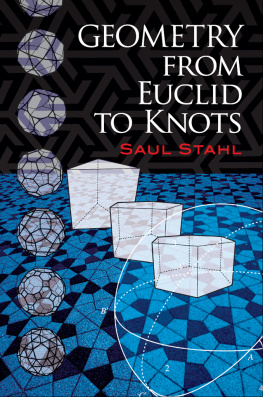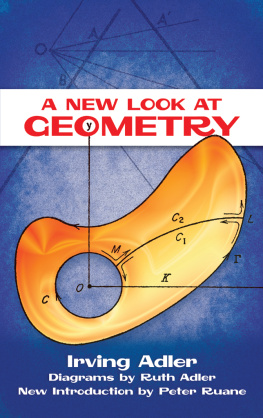A MODERN VIEW OF GEOMETRY
A MODERN VIEW OF GEOMETRY
Leonard M. Blumenthal
DOVER PUBLICATIONS, INC.
Mineola, New York
Copyright
Copyright 1961, 1989 by Leonard M. Blumenthal
All rights reserved.
Bibliographical Note
This Dover edition, first published in 1980 and reissued in 2017, is an unabridged and corrected republication of the work originally published in 1961 by W. H. Freeman and Company, San Francisco.
Drawings by Evan Gillespie.
International Standard Book Number
ISBN-13: 978-0-486-63962-8
ISBN-10: 0-486-63962-2
Library of Congress Catalog Card Number: 7956332
Manufactured in the United States by LSC Communications
639622052017
www.doverpublications.com
Preface
T HE TITLE of this book may recall to the reader a celebrated work of three volumes written by the German mathematician, Felix Klein, and published almost exactly fifty years ago. The second volume of Kleins Elementare Mathematik vom Hhere Standpunkt aus is devoted to geometry, but the modern viewpoint from which we shall examine certain parts of geometry has almost nothing in common with the higher standpoint from which that distinguished writer surveyed the subject.
The abstract, postulational, method which has now permeated nearly all parts of mathematics makes it difficult, if not meaningless, to mark the boundary of that mathematical province which is called geometry. There is wisdom as well as wit in saying that, geometry is the mathematics that a geometer does, for today perhaps geometry more properly describes a point of viewa way of looking at a subjectthan it denotes any one part of mathematics.
Our principal concern is with the postulational geometry of planes, with the greatest emphasis on the coordinatization of affine and projective planes. It is shown in detail how the algebraic structure of an abstract coordinate set is determined by the geometric structure that postulates impose on an abstract point set. It is seen that the process can be reversed: a geometric entity (plane) arises from an initially given algebraic entity (ternary ring), and the geometric properties of the one are logical consequences of the algebraic properties of the other. The essential amount to a study of ordinary analytic geometry from a higher standpoint, and should be very illuminating to the thoughtful student.
Chapter VII contains a detailed development of a simple set of postulates for the euclidean plane, and gives postulates for the non-euclidean planes.
It is believed that much of the books content is accessible to college students and to high school teachers of mathematics, and that the first three chapters (at least) could be read with profit by the celebrated man in the street. A postulational approach to a subject usually makes very slight demands on the readers technical knowledge, but it is likely to compensate for this by exacting from him close attention and a genuine desire to learn.
It is hoped that this book might be useful in National Science Foundation Summer Institutes. This is, indeed, an expanded version of a course given by the author at such an Institute, held at the University of Wyoming during the summer of 1959. If the book is used as a text (or for supplementary reading) in a graduate course devoted to modern postulational geometry, the first three chapters might well be omitted. On the other hand, constitute more than enough material for an enlightening course in a summer institute for high school teachers of mathematics.
The material of makes considerable use of L. A. Skornyakovs monograph, Projective Planes (American Mathematical Society, Translation Number 99, 1953). Much of the material in both of these articles has its source in the pioneering work of Marshall Halls Projective Planes (Transactions American Mathematical Society, vol. 54, 1943, pp. 229277).
stems from some contributions made by the author to distance geometry. A detailed account of this subject is given in his Theory and Applications of Distance Geometry, Clarendon, 1953.
The author wishes to record his deep appreciation of Mrs. Kay Hunts excellent typing of the manuscript.
January 1961
Leonard M. Blumenthal
University of Missouri-Columbia
Contents
A MODERN VIEW OF GEOMETRY
I
Historical Development of the Modern View
I.1.The Rise of Postulational Geometry. Euclids Elements
It is often said that geometry began in Egypt. The annual inundations of the Nile swept away landmarks and made necessary frequent surveys so that one mans land could be distinguished from that of his neighbors. These surveys did indeed give rise to a collection of geometrical formulas (many of which were merely approximations), but the Egyptian surveyors were no more geometers than Adam was a zoologist when he gave names to the beasts of the field.
For the beginnings of geometry as a deductive science we must go to ancient Greece. Through the efforts of many gifted fore-runners of Euclid, such as Thales of Miletus (640546 B.C.), Pythagoras (580?500? B.C), and Eudoxus (408355 B.C.), many important geometrical discoveries were made. Plato was fond of the subject, and though he made few original contributions to it he emphasized the need for rigorous demonstrations and thus set the stage for the role Euclid was to play.
The postulational procedure that stamps so much of modern mathematics was initiated for geometry in Euclids famous Elements. This epoch-making work, written between 330 and 320 B.C., has probably had more influence on the molding of our present civilization than has any other creation of the Greek intellect. Though far from attaining the perfection it aspired to, the Elements commanded the admiration of mankind for more than two thousand years and established a standard for rigorous demonstration that was not surpassed until modern times.
Euclid was the greatest systematizer of his age. Few, if any, of the theorems established in the Elements are his own discoveries. His greatness lies in his organization, into a deductive system, of all of the geometry known in his day. He sought to select a few simple geometric facts as a basis and to demonstrate all of the remainder as logical consequences of them. The facts he chose as a basis he called axioms or postulates. No proofs are given for themthey were the building blocks used to derive the theorems of his system.
We shall discuss postulational systems in Chapter II, but we may observe at once that every such system has a set of unproved statements as a basis. These statements are called axioms or postulates, or merely assumptions. Though Euclid applied the term axiom to so-called common notions that were not peculiar to geometry (for example, if equals are added to equals, the sums are equal) and reserved the term postulate for assumptions of a geometrical nature (for example, two points may be joined by a line), this distinction is not usually observed today. In this book we shall usually call our assumptions postulates.
Euclid selected five geometrical statements as the basis for his deductive treatment and introduced them in the following manner:
Let the following be postulated:
I. To draw a straight line from any point to any point.
II. To produce a finite straight line continuously in a straight line.
III. To describe a circle with any center and distance.
IV. That all right angles are equal to one another.
V. That, if a straight line falling on two straight lines makes the interior angles on the same side less than two right angles, the two straight lines, if produced indefinitely, meet on that side on which are the angles less than the two right angles.

